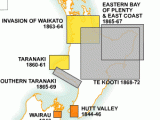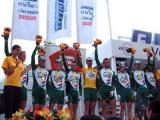What happened that day?
See historic events for any day of the year by entering the date below. Why not try your birthday?
Kiwi of the Week
Today in History

1863 British forces invade the Waikato
On 12 July 1863 British troops invaded Waikato by crossing the Mangatāwhiri stream. The Kīngitanga had declared this to be an aukati (a line that should not be crossed), any breach of which would be an act of war.
The Kīngitanga or Māori King Movement had been established in 1858. The settler government saw it as an anti-land-selling league and an impediment to the progress of European settlement. The involvement of Kīngitanga warriors in fighting in Taranaki in 1860–61 fuelled fears that this was a separatist movement that challenged British sovereignty in New Zealand. In January 1863, Governor George Grey announced his intention to ‘dig around the Kīngitanga until it fell’.
Rumours of an imminent Maori attack on Auckland from Waikato increased the tension. Settlers and missionaries fled Waikato after a number of violent incidents. Grey exploited the situation to convince the authorities in London to back his request for more soldiers.
When fresh fighting erupted in Taranaki in the autumn of 1863, the alleged involvement of Kīngitanga forces in an ambush at Ōakura gave Grey the excuse he needed. He now had thousands of troops at his disposal. In July he gave all Māori living between Auckland and the Waikato River an ultimatum: swear allegiance to the Queen and give up their arms, or be deemed to be in rebellion and face the consequences. Three days later, Lieutenant-General Duncan Cameron crossed the Mangatāwhiri stream with the declared intention of establishing military posts on the Waikato River. The Waikato War had begun.
Image New Zealand Wars map

2001 New Zealander wins Tour de France stage
The first stage win by a New Zealander in the Tour de France came in a team time trial. Although Chris Jenner didn’t finish with the core of his Credit Agricole team, he shared in the stage win and got to stand on the podium. (In 2011 Julian Dean achieved the same thing with his Garmin-Cervélo team.)
Few New Zealand riders have completed the world’s greatest cycle race. The first was Harry Watson, who in 1928 was part of a four-main ‘down-under’ team. The team was supposed to have 10 riders, but their six European teammates failed to show up – a major handicap in a tour with 15 stages of more than 380 km. Watson still managed an impressive 28th overall.
Our highest-placed Tour rider ever was Tino Tabak, who finished 18th overall in 1972. Eric McKenzie completed four Tours in the early 1980s, finishing third in one stage. Nathan Dahlberg (1988), Stephen Swart (1994, 1995), Hayden Roulston (2009) and Julian Dean (2004, 2006, 2007, 2008, 2009, 2010, 2011) are the other New Zealand finishers. In 2009 New Zealand had two riders in the Tour peloton for the first time, Dean and Roulston. The latter finished third in stage 14.
Julian Dean has gained a reputation as one of the best lead-out men in the world, helping set up his team’s fastest rider as they reach speeds of up to 80 km/hr before crossing the finishing line in the frantic and dangerous sprint stages. In 2009 he joined the Garmin-Slipstream (now Garmin-Cervélo) team working for the young American sprinter Tyler Farrar. With Farrar abandoning the 2010 Tour de France because of injury, Dean achieved two second places (stages 4 and 18) and a third (final stage on the Champs-Élysées in Paris) – the best individual stage results ever by a New Zealand rider at the Tour.
Chris Jenner retired from professional racing in 2004. Apart from his Tour stage, he won the overall Le Télégramme in 2002, two stages and the overall Tour of Wellington in 2001, and stages in the Tour de l’Ain and the Tour de l’Avenir in 1999.
Image: Credit Agricole on the podium (cyclingnews.com)




















